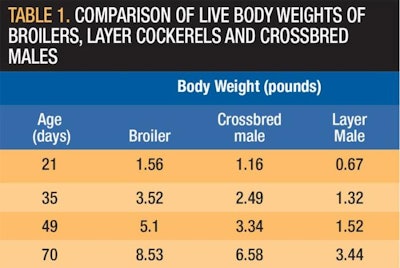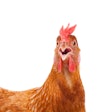
The modern poultry industry has achieved rapid improvements in bird performance and cost reduction for egg and meat production. Some of these improvements have come because of the evolving selection and statistical techniques that have been employed, but a good deal of the progress has been realized because layer and broiler strains have been selected independently.
“Dual purpose hampers the progress of productivity,” said Dr. Rudolf Preisinger, managing director and chief geneticist, Lohmann Tierzucht. He told the audience at the recent International Egg Commission meeting in Vienna that “there is a biological antagonism between meat and eggs. If you select chickens for a high rate of lay, you get a lean breast. It is not about the growth rate; it is really about the breast. Today in the broiler business we are focusing on the breast only, at least in Europe and North America. In some Asian countries they prefer more leg meat, but it is only a small percentage of the total broiler market.”
Requirements for today’s layers
Preisinger said primary breeders need to be able to forecast the needs for producers and consumers at least five years ahead of when the market will need it. “Five years is the minimum,” he said. “Different markets can be served by different line combinations, primarily on the male line side.”
Layers have to be adaptable to different environments, housing systems, climates and levels of feed quality. He said that layers must be feather or color sexable at hatch.
Preisinger said you need to have extensive gene pools with a variety of elite lines to generate specific commercial products. The current target of layer breeding programs is a longer single lay production period with more saleable eggs per hen housed. He said this will be accomplished by extending the laying period along with long-lasting good shell quality and continuous improvement in livability.
Economic performance of the hens will be improved because of high rate of lay and strong egg shells until the end of the lay cycle. Other factors for improving return per hen will be a reduction in the feed required to produce an egg and selection for hens that don’t need special high-density diets to achieve high performance. Persistency of lay has been improved in today’s layers. Preisinger said that, in tests, around 50 percent of white laying hens lay an egg every day for over 100 days or just take one day off. He said these birds also produce eggs of consistent size.
The male chick dilemma
If you don’t euthanize layer cockerels at hatch, what do you do with them? Currently, some European hatcheries are selling these chicks for use as food for zoo animals. Animal welfare/rights advocates have suggested that the cockerels be raised for meat for human consumption or that the industry go back to using a multipurpose chicken, one that can be used to produce eggs and meat.
Lohmann Tierzucht has produced a dual-purpose (crossbred) bird by crossing a male-line broiler with a female-line dwarf brown layer. They conducted tests raising broilers and cockerels from the layer line and the crossbred line. The layer cockerels required 70 days to reach a live weight of 3.44 pounds, and Preisinger said they were poorly fleshed (Table 1). The crossbred males were 6.58 pounds at 10 weeks of age, nearly two pounds lighter than the broilers were.
The breast meat and slaughter yields were higher in the 70-day-old broilers than in the crossbred cockerels (Table 2). Feed conversion to 70 days was 2.5 for the crossbred birds and 4.0 for the layer cockerels.
Crossbred hens produced 250 eggs to 68 weeks versus 290 eggs for the layer hens (Table 3). In addition to producing fewer eggs, the crossbred hens ate a lot more feed and this resulted in crossbred hens consuming 39 percent more feed per egg produced than the layer hens did.
In short, the crossbred strain has hens that lay fewer eggs and eat more feed than layer strain hens and cockerels that produce less meat and eat more feed than broiler strains do. Preisinger said the crossbred dual-purpose bird has a “negative eco-balance.”
Lohmann Tierzucht has had the dual-purpose crossbred line on the market for more than a year, according to Preisinger. He said they have placed less than 50,000 of these crossbred birds in Switzerland, Austria and Germany.
Prehatch sexing
Preisinger said that even genomic selection won’t allow primary breeders to find genes for breast meat yield in layer lines. He said sex determination in the egg prior to hatch will ultimately be a more efficient solution to the layer cockerel dilemma than dual purpose chickens. He said his company is involved in some in ovo sexing projects that look promising. He estimated that it will cost around 0.5 Euros per female chick to do the sexing. Current testing techniques are yielding 98 percent accuracy with a 3 percent loss of hatchability.
















